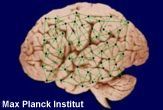The Human Brain Seen as Master of Time

Your brain is a time machine with three modes that control everything from instantaneous tasks like moving to maintaining long trains of thought and ultimately staying in synch with night and day.
That's what scientists say. But they have no clue how most of it works.
Focusing on the poorly understood middle time zone, where the brain does some of its best work, researchers at Duke University summarize this latest thinking in a new article in the journal Nature Reviews Neuroscience.
Scientists have long understood human and animal brains to be governed in part by a circadian clock, which keeps us in synch with night and day. The rhythm of this 24-hour clock encourages nighttime sleep and allows many people to awaken with no help from a rooster.
Another clock is thought to operate at the millisecond level, controlling movement and speech, among other vital functions that occur so quickly we don't really think about them.
But in between, there must be a third timekeeper of the mind to aid all the functions that require seconds to minutes of attention. Nobody is sure about this, though.
Interval timing
Sign up for the Live Science daily newsletter now
Get the world’s most fascinating discoveries delivered straight to your inbox.
Duke neuroscientists Warren Meck and Catalin Buhusi call the middle mode "interval timing."
"To understand speech, I not only have to process the millisecond intervals involved in voice onset time, but also the duration of vowels and consonants," Meck said Friday. "Also, to respond, I need to process the pacing of speech, to organize my thoughts coherently and to respond back to you in a timely manner."
Interval timing has not been studied in detail. In fact it may be very hard to look into it.
Meck has been pondering it since the 1980s, but little progress has been made in pinning down how it works. He suspects the interval-timing clock does not reside in a single location, as is the case with smell, taste and other senses. Even the circadian clock is located in one part of the brain.
But interval timing "has to be distributed so it can integrate information from all the senses," Meck said today.
Figuring out how it works may turn out to be more important in understanding the brain that the spatial connections between various parts of the brain.
"I would argue that time is more fundamental than space, because one can just close one's eyes and relive memories, going back in time," Buhusi says, "or prospectively go forward in time to predict something, without actually changing your position in space."
The conductor and his orchestra
Theorists used to think interval timing was orchestrated by some sort of biological pacemaker that emitted timing pulses.
The new thinking is that the various parts of the brain oscillate and all these oscillations are monitored and integrated by certain circuits, perhaps in the basal ganglia, an area of the brain that controls basic functions such as movement.
"It's like a conductor who listens to the orchestra, which is composed of individual musicians," Buhusi explains. "Then, with the beat of his baton, the conductor synchronizes the orchestra so that listeners hear a coordinated sound."
The new paper by Meck and Buhusi lists the various challenges to cracking the interval timing mechanism and outlines techniques being employed. As with many attempts to understand the brain, researchers are looking at what happens when it stops working normally.
"When Parkinson's patients are on their medication, they time quite normally," Meck said. "But as their medication wears off, we can see their clock slow down by recording their brain signals."
Related thoughts:
Robert is an independent health and science journalist and writer based in Phoenix, Arizona. He is a former editor-in-chief of Live Science with over 20 years of experience as a reporter and editor. He has worked on websites such as Space.com and Tom's Guide, and is a contributor on Medium, covering how we age and how to optimize the mind and body through time. He has a journalism degree from Humboldt State University in California.
